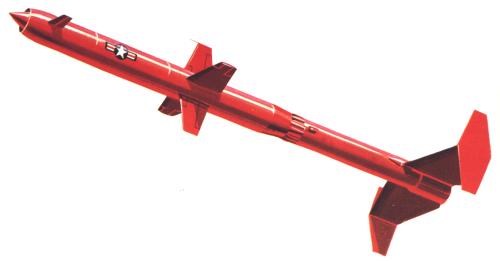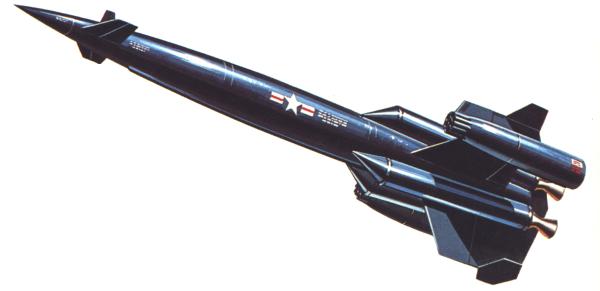Grumman SSM-N-6 Rigel
In 1946 the U.S. Navy begun the Rigel program to develop a submarine-launched supersonic shore-bombardment missile. The missile was subsequently designated SSM-6, soon changed to SSM-N-6. The Rigel was to be a twin ramjet-powered cruise missile to be launched by a large catapult and multiple solid-propellant rocket boosters. The development program started with launches of several Rigel test vehicles to test the ramjet propulsion system. These test vehicles were of completely different layout than the planned SSM-N-6 tactical missile, and had only a single ramjet and a single in-line rocket booster. The next step the development program were scaled-down FTVs (Flight Test Vehicles) with a configuration similar to the full-scale tactical missile. The first FTV was launched in May 1950.
 |
| Image: U.S. Navy |
| Rigel ramjet test vehicle |
The operational SSM-N-6 Rigel was designed with two wingtip-mounted Marquardt 71 cm (28 in) ramjets and four rocket boosters. The missile had a range of 930 km (500 nm) and was guided by a modified LORAN system. Two guidance submarines along the flight path would have been used as beacons which were interrogated by the missile to obtain location information. When the predetermined target location was reached, the Rigel would have entered either a preprogrammed or a ballistic flight path towards the point of impact. It was hoped to achieve an accuracy of 550m (600 yd) CEP with this system. The intended warhead for Rigel was a W-5 nuclear fission warhead, but it's possible that the final operational missile would have used a W-27 thermonuclear device.
 |
| Image: U.S. Navy |
| XSSM-N-6 |
The full-scale XSSM-N-6 prototypes were to have followed the FTV flight tests, but the Rigel program was cancelled in August 1953, mainly because of repeated failures of the FTVs. By that time, only a mockup of the XSSM-N-6 had been completed. Another reason quoted for the cancellation is that the ramjet-powered Rigel would have required a much longer launch rail than the contemporary turbojet-powered SSM-N-8/RGM-6 Regulus, which would have been a major concern for deployment on submarines.
Specifications
Note: Data given by several sources show slight variations. Figures given below may therefore be inaccurate!
Data for XSSM-N-6:
| Length | 14.05 m (46 ft 1 in) |
| Wingspan | 4.06 m (13 ft 4 in) |
| Diameter | 1.14 m (45 in) |
| Weight (incl. boosters) | 10800 kg (23800 lb); w/o boosters: 5890 kg (13000 lb) |
| Speed | Mach 2 |
| Ceiling | 16000 m (52500 ft) |
| Range | 930 km (500 nm) |
| Propulsion | Sustainer: 2x Marquardt 28" ramjet; 26.7 kN (6000 lb) each Booster: 4x solid-fueled rocket; 35.6 kN (8000 lb) each |
| Warhead | W-5 nuclear fission (47 kT) |
Main Sources
[1] Norman Friedman: "US Naval Weapons", Conway Maritime Press, 1983
[2] Frederick I. Ordway III, Ronald C. Wakeford: "International Missile and Spacecraft Guide", McGraw-Hill, 1960
[3] Bill Gunston: "The Illustrated Encyclopedia of Rockets and Missiles", Salamander Books Ltd, 1979
[4] Kenneth P.Werrell: "The Evolution of the Cruise Missile", Air University Press, 1985
Back to Directory of U.S. Military Rockets and Missiles, Appendix 1
Last Updated: 5 January 2003